The following list is only a small portion of all of the various filming formats that have been used. Because so many different formats have existed, only the more popular or significant filming formats are listed. Click on any image to see a larger version.
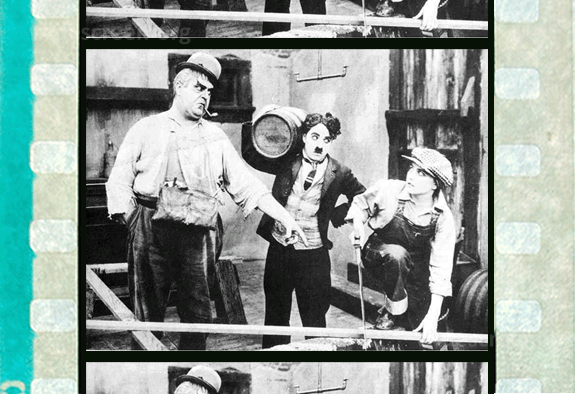 Example of a 1.33:1 silent film frame. This composite is from my own film scans and a screen shot from The Gold Rush, which is in the public domain.
Example of a 1.33:1 silent film frame. This composite is from my own film scans and a screen shot from The Gold Rush, which is in the public domain.
Flat/Spherical
Aspect ratios: Various
Flat (or "spherical") lenses are used to produce an uncompressed image on the film. When projecting from 35mm film onto a screen, special requirements are usually not needed to project the image on the screen, depending on the final aspect ratio (AR).
Formats like Super 35 are filmed using flat lenses but are often cropped to achieve the intended AR. If the final result is wider than a 1.85:1 image, the final product will usually be anamorphically compressed thus requiring anamorphic projection lenses to expand the image to the correct AR.
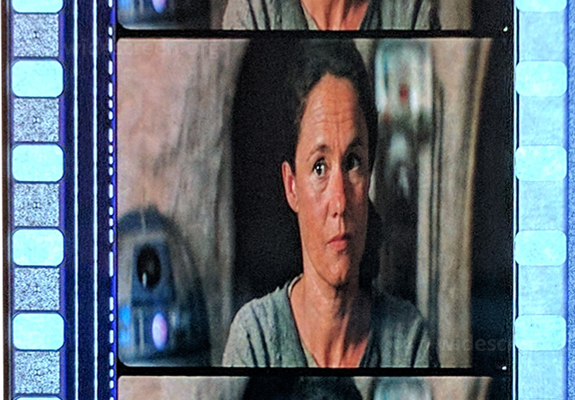 The Phantom Menace ©1999 Lucasfilm, Ltd.
The Phantom Menace ©1999 Lucasfilm, Ltd.
Image taken by yours truly from a 35mm strip that was included with The Phantom Menace widescreen VHS box set.
Anamorphic
Aspect ratios: Various, generally 2:1 to 2.76:1
Originally designed by Henri Chrétien during World War I for military reasons, anamorphic lenses are used specifically for widescreen presentations. By compressing the image horizontally, more of the image can be stored in the frame. The final projection (when shown through an anamorphic projector lens of the same power) will have a much wider aspect ratio than the film frame itself, resulting in a panoramic view. This format produces high quality projections because the entire frame is used.
Although the traditional anamorphic format utilized an AR of 2.35:1, the AR of most 35mm anamorphic movies since 1970 is more accurately 2.39:1. Often, this is rounded up to 2.40:1. In many areas the "2.35:1" moniker has stuck in the same way that "scope" is still used by people in the industry for films made with anamorphic lenses even though CinemaScope has not been used since 1967.
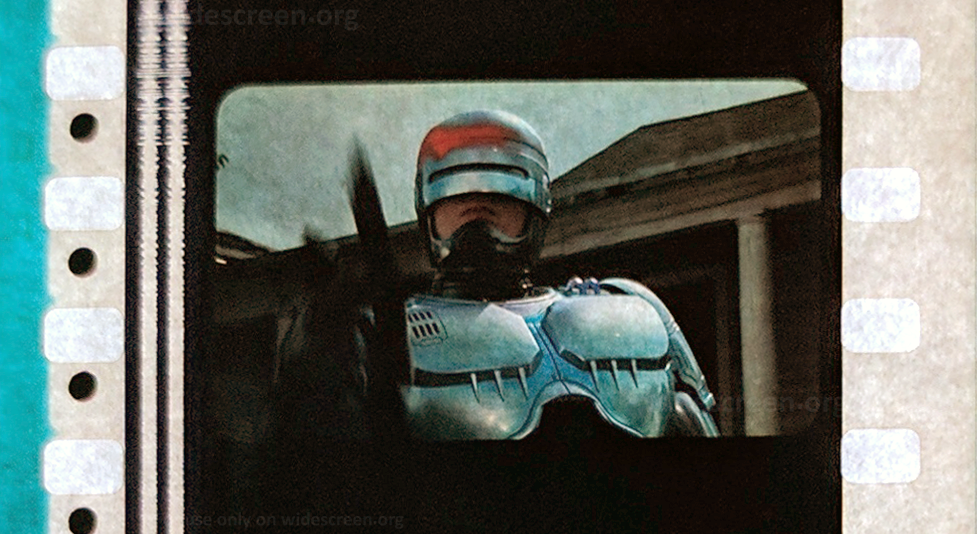 Standard 4-perf 35mm frame from Robocop 2 matted to apprx. 1.7:1. © 1990 Orion Pictures
Standard 4-perf 35mm frame from Robocop 2 matted to apprx. 1.7:1. © 1990 Orion Pictures
Image taken by yours truly from a 35mm "No Smoking" bumper for Robocop 2.
Matted
Aspect ratios: 1.66:1 to 2.35:1
Matted aspect ratios have been in use primarily from the early 1950s as a framing device to produce a widescreen effect from a standard 1.37:1 frame. Soft matte usually involves filming and delivering the complete 1.37:1 frame with the expectation that the top and bottom will be matted out at the projector to achieve the intended aspect ratio. Alternately, mattes can be added during post-production. Hard matte involves masking the frame in camera during the shoot.
The Super 35 format (see below) is similar to open matte in that it can produce a very wide AR by using only a portion of the 1.37:1 frame, which results in a grittier look and feel. The use of soft matte has resulted in unintended gaffes when such movies are converted to another format with the mattes removed, which happened often with "full screen" DVDs. Because the mattes usually hid boom mikes and other equipment, such equipment could then be seen in the open matte versions.
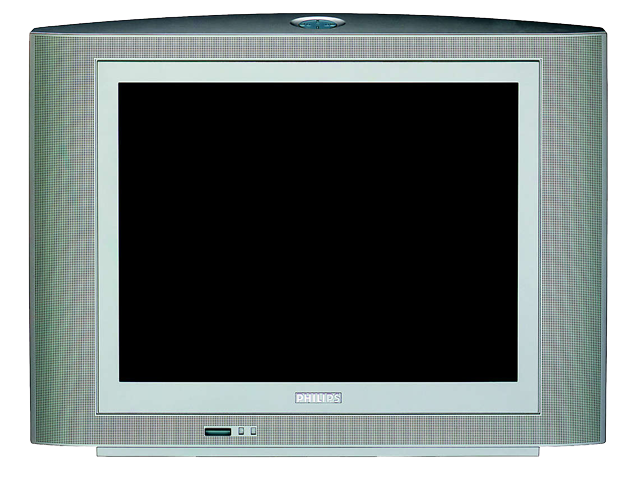
1.33:1 (or 4:3)
For several decades, the standard TV format was 4:3 or 1.33:1, where the screen was 1.33 times wider that its height, in order to match the Academy ratio that people had become accustomed to, including many in the industry. Although engineers could have chosen any aspect ratio that they wanted, film would be used as source material (since videotapes as we know them didn't exist at the time); so using an AR closer to the Academy ratio made sense.
Note that this has nothing to do with resolution or signal requirements. Although both NTSC and PAL were designed for 4:3 TVs, the two technologies are not compatible.
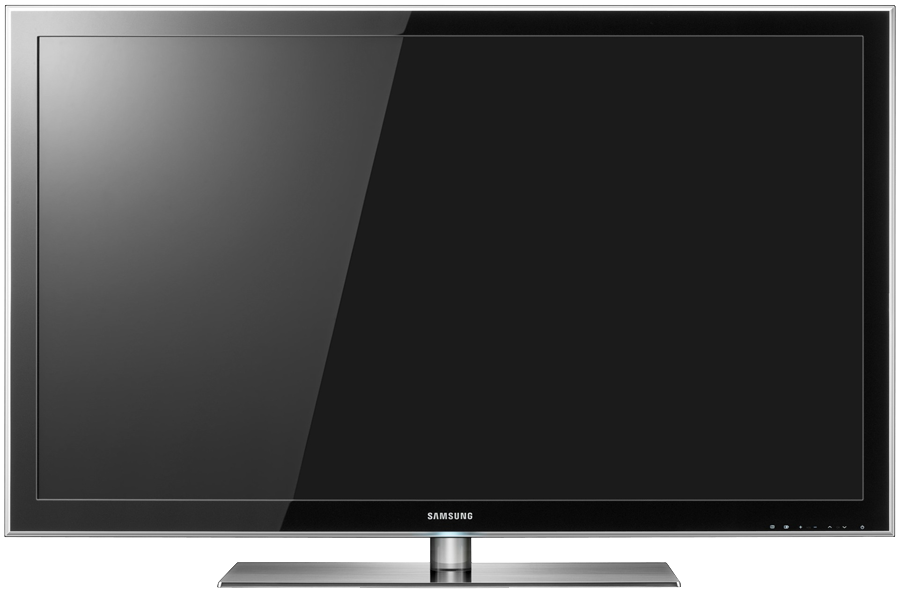
1.77:1 (or 16:9)
The 16:9 format was proposed in the early 1980s by Dr. Kerns H. Powers, who concluded that 16:9 was the appropriate aspect ratio to use to more easily accommodate the various aspect ratios that were being used at the time, ranging from the 1.33:1 TV standard to the 2.39:1 CinemaScope/anamorphic standard. The 16:9 format was standardized by the International Telecommunication Union's ITU-R Recommendation BT.709 in 1990. In July 1993, the European Union approved the 16:9 Action Plan "to ensure the accelerated development of the market for advanced television services in the 16:9 format".
1.33:1 content is correctly shown in the center of the screen in a pillarbox format with unused areas on the sides. Widescreen content 1.85:1 or greater will still have "black bars" on the top and bottom, but they will be narrower than the same content as shown on 4:3 screens.
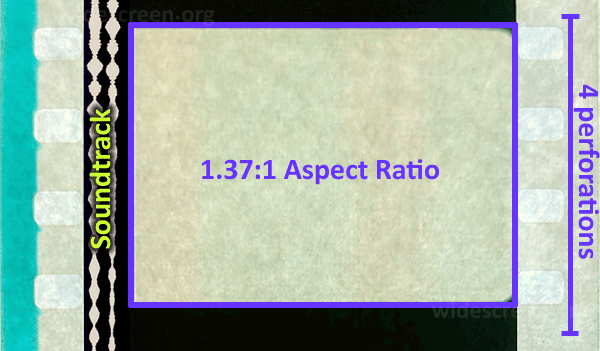 Composite example was made by yours truly from multiple 35mm film sources.
Composite example was made by yours truly from multiple 35mm film sources.
Academy Ratio
Aspect ratios: 1.37:1, can be matted to 1.66:1, 1.76:1 or 1.85:1
Following a failed attempt to standardize on a 1.33:1 AR (due to the implementation of an analog soundtrack in movies) in the early to mid-1920s, the Academy of Motion Picture Arts and Sciences agreed upon a modified standard of 1.37:1, which was then called the "Academy Ratio". This was approved by the Society of Motion Picture Engineers in May 1932.
All movies made in Hollywood were filmed in this AR until widescreen cinematography appeared (again) to combat television in the early 1950s at which time most "flat" movies were matted to wider aspect ratios.
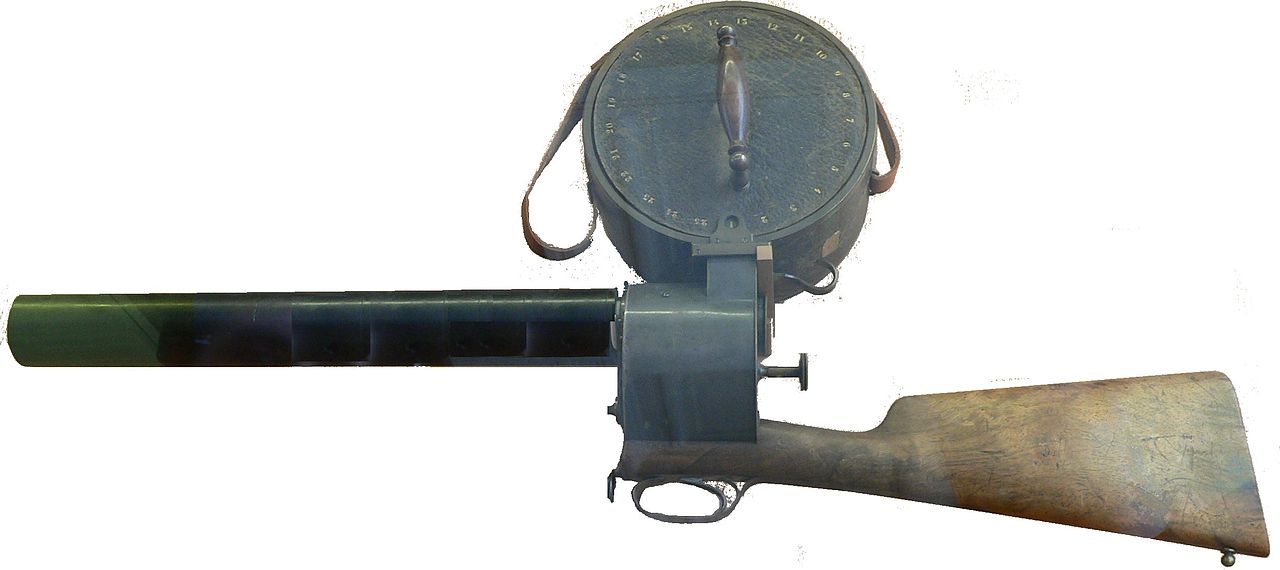 Marey Chronophotography gun
Marey Chronophotography gun
Image by David Monniaux, courtesy of Wikimedia
Chronophotography
Developed by Étienne-Jules Marey in 1882, the chronophotographic gun was primarily used to study the movement of humans, animals, and insects. Incorporated with a revolving disc of photographic plates, the gun was capable of taking 12 consecutive frames per second. The 12 frames could then be played in sequence like animation or assembled into a single photo. Later versions could shoot 60 frames per second.
Marey's chronophotographic gun was a forerunner to the motion picture camera.
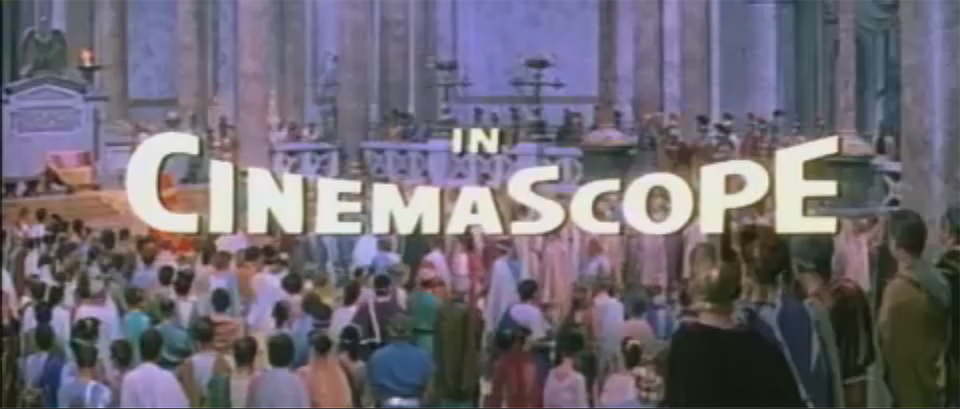 Frame from the trailer for The Robe (1953) with an aspect ratio of 2.35:1
Frame from the trailer for The Robe (1953) with an aspect ratio of 2.35:1
CinemaScope
Aspect ratios: 2.35:1 to 2.66:1
Developed in the early 1950s by Earl Sponable, head of research at 20th Century Fox, CinemaScope was made to easily let existing theaters retrofit their systems to show widescreen movies. Based on the designs of Henri Chrétien, Sponable worked with Bausch & Lomb to correct optical and functional defects in Chrétien's initial designs. Although CinemaScope was capable of an aspect ratio of 2.66:1, the final AR was reduced to 2.35:1 with the introduction of an optical soundtrack.
Although CinemaScope was last used in 1967, the term "scope" is still used by projectionists and filmmakers to refer to any movie that utilizes anamorphic lenses or with an aspect ratio of 2.35:1 or greater.
Notable titles: The Robe (1953), Guys and Dolls (1955), Lady and the Tramp (1955), Oklahoma! (1955), Forbidden Planet (1956)
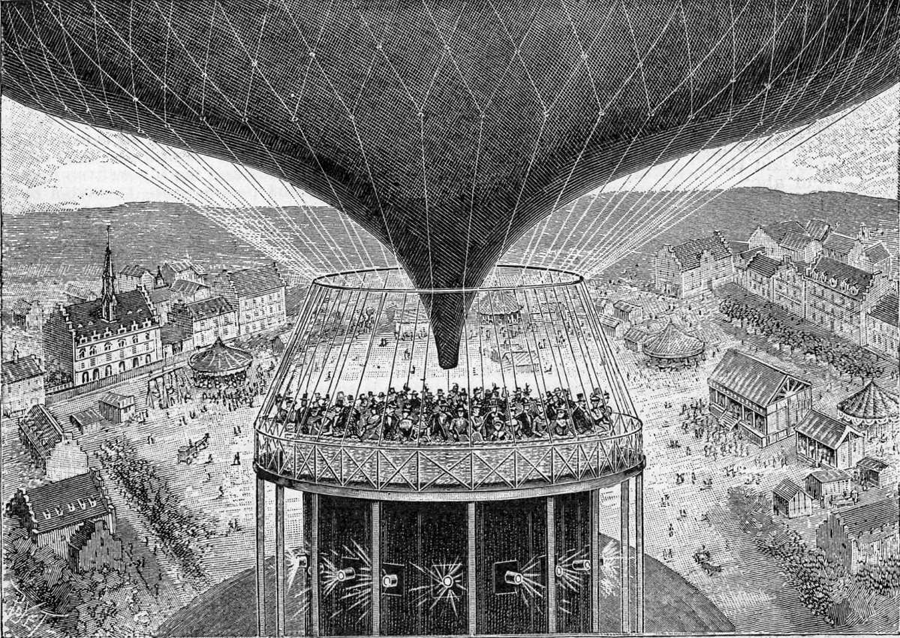 Woodcut of Cinéorama at 1900 Paris Exposition.Courtesy of Wikimedia.
Woodcut of Cinéorama at 1900 Paris Exposition.Courtesy of Wikimedia.
Cinéorama
Cinéorama was an experiment for the 1900 Paris Exposition that involved 10 synchronized 70mm projectors that were arranged to provide a full 360° experience simulating a hot-air balloon flight. The footage was recorded 400m above the Tuileries Garden. The experiment was shut down after three days because of fear of being a fire hazard due to the extreme heat of the arc lights from the 10 projectors that were underneath the audience.
Although it was never shown again, it demonstrated the ability to have multiple projectors in sync, which would be critical to formats like Cinerama and Polyvision. Its direct successor, Disney's Circle-Vision 360°, was in use at various Disney properties since 1955 but is now only used at EPCOT Center.
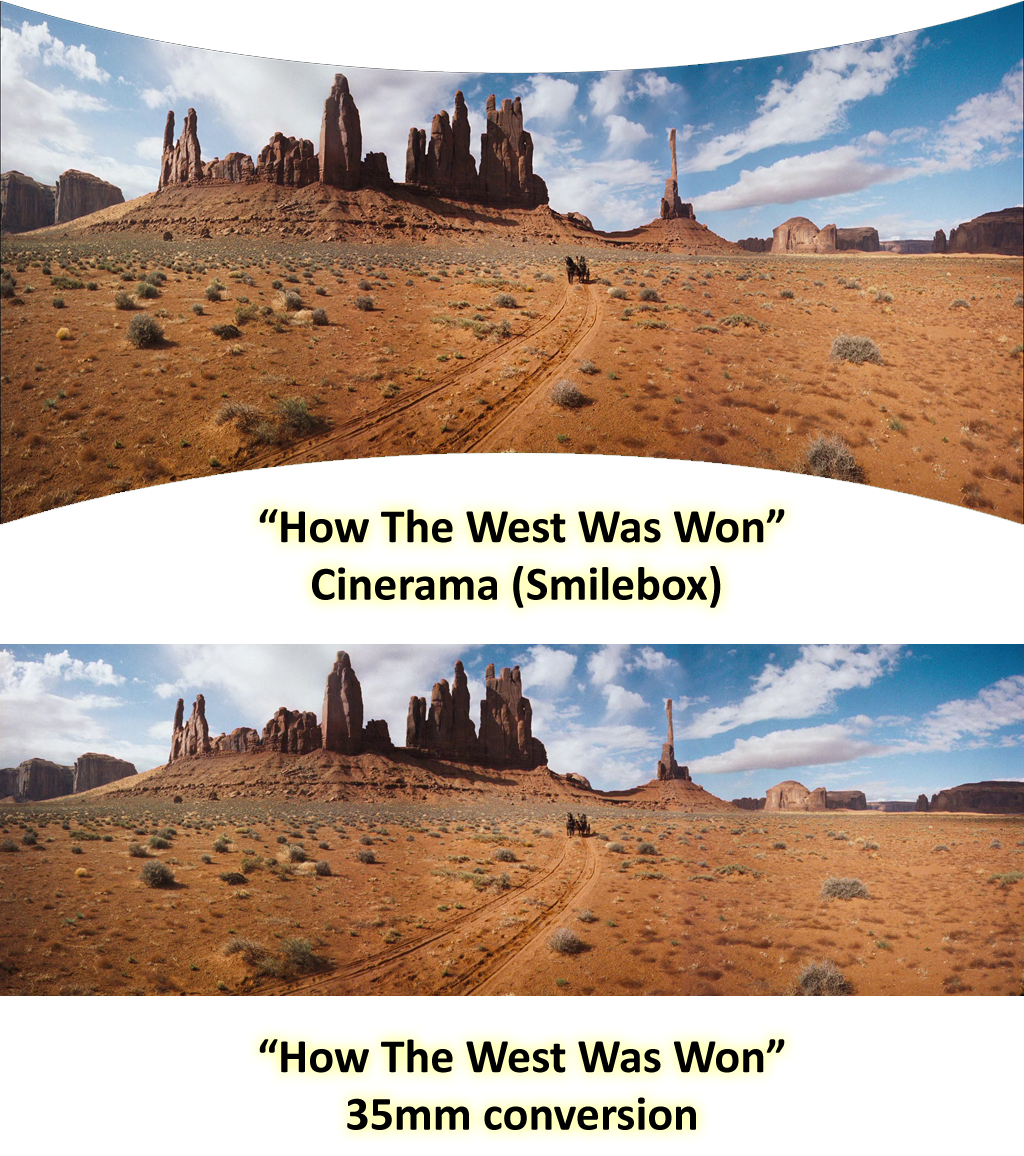 Cinerama example of How The West Was Won
Cinerama example of How The West Was Won
© 1962 MGM
Cinerama
Aspect ratios: 2.59:1 to 2.65:1
Cinerama was the first widescreen format to be introduced after the Academy Ratio became a standard in 1932. It involved projecting images from three synchronized 35mm projectors onto a deeply-arced screen. Although the final result had an optimal aspect ratio of 2.65:1, no anamorphic lenses were used. Cinerama was one of the first film formats to use magnetic media for audio, utilizing seven discrete audio channels.
Cinerama made its debut with This Is Cinerama in 1952 at the Broadway Theatre in New York. Although it was more of a technology demo than an actual movie, it was the first time that people had the opportunity to see a widescreen movie since the adaptation of the Academy ratio.
When the use of three cameras became unprofitable, films were often shot in Ultra Panavision 70 which was then optically converted to a three-film Cinerama format for theatrical playback.
Notable titles: How The West Was Won (1962), It's A Mad, Mad, Mad, Mad World (1963), 2001: A Space Odyssey (1968)
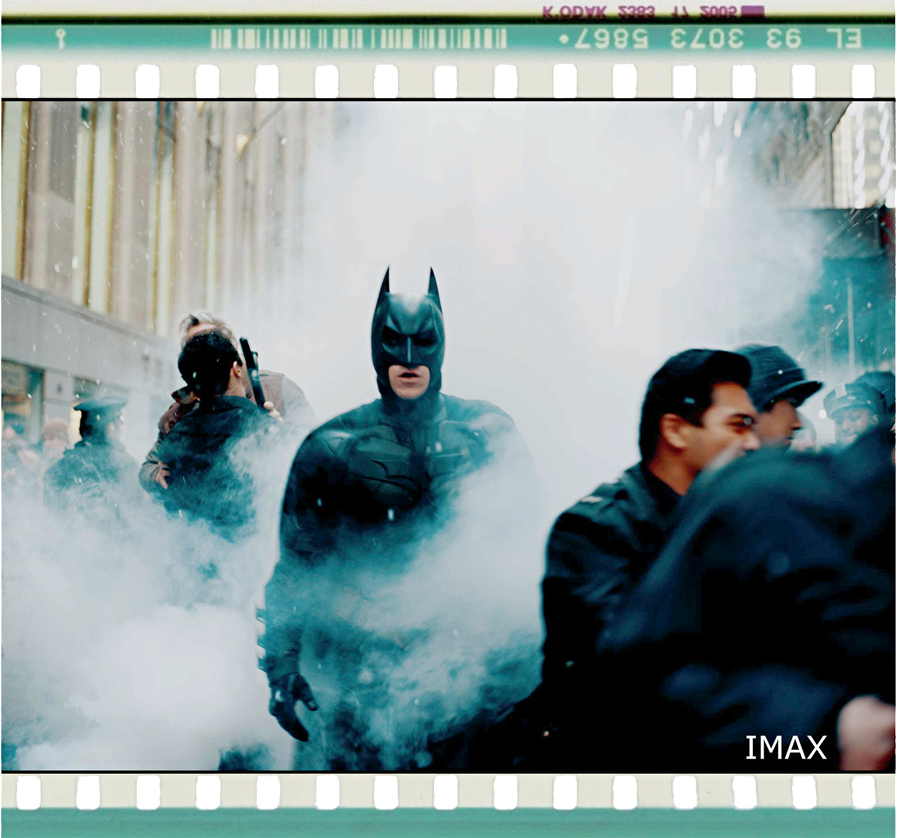 IMAX 70m frame from The Dark Knight Rises. Courtesy of The New York Times
IMAX 70m frame from The Dark Knight Rises. Courtesy of The New York Times
IMAX
Aspect ratios: either 1.43:1 or 1.90:1
IMAX was developed in Canada in the late 1960s and early 1970s with the idea that a large, single screen was a better viewing experience than multiple smaller screens, particularly Cinerama. The original IMAX design uses 70mm film that is shown horizontally with a massive 15 perforations per frame, giving it approximately 6x the resolution of a traditional 35mm film frame. The average IMAX screen size is approximately 72' x 50' (22m x 16m), which is significantly larger than traditional movie screens of approximately 50' x 20' (16m x 6.1m). IMAX also helped to popularize dome projection with the OMNIMAX at the San Diego Hall of Science.
IMAX cameras are well-regarded by many filmmakers and are often used during high-action scenes for greater clarity and impact.
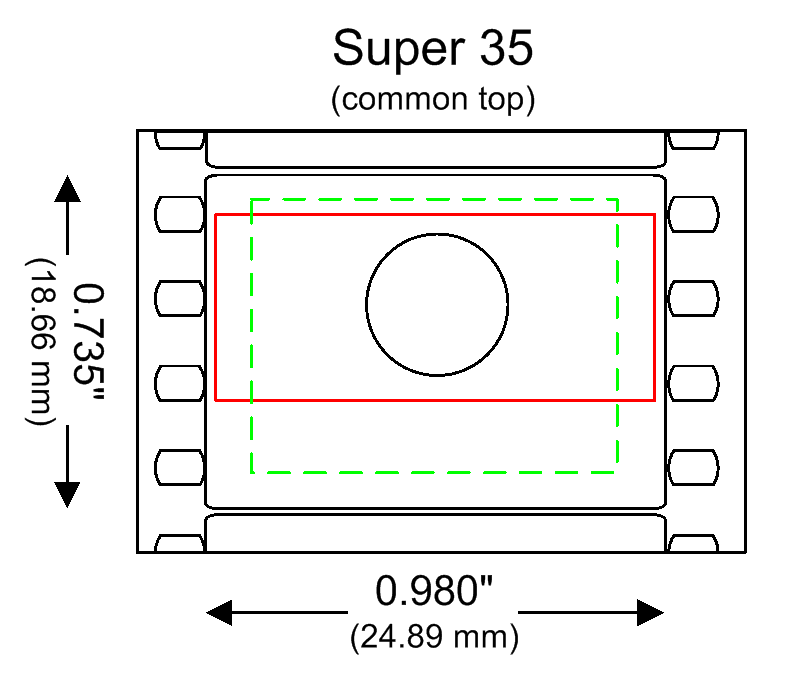 Exmaple of a Super 35 frame.
Exmaple of a Super 35 frame.
Yellow = section used for 4:3 TVs
Red = section used for 2.35:1 movies
Image courtesy of Wikipedia
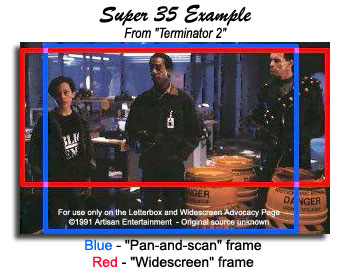 Example of Super35 back in the "pan-and-scan" days. Image is a relic from previous iterations of widescreen.org.
Example of Super35 back in the "pan-and-scan" days. Image is a relic from previous iterations of widescreen.org.
Super 35
Aspect ratios: 1.33:1 to 2.35:1
Super 35 is a film format that uses the same 35mm stock that is used in any other format, except the space that is normally used by the soundtrack is also used. Super 35 is also used to produce widescreen movies by cropping the visual frame to the intended aspect ratio. The result would then be stretched as needed to fill the 35mm frame for distribution. This allowed for a "grittier" look to the visuals (compared to using anamorphic lenses) because the final result was derived from a lower resolution.
Another key factor is that its use of flat lenses allows for certain kinds of scenes to be filmed using forced perspective while keeping the intention of a widescreen release. In The Lord of the Rings trilogy (2.35:1 AR), Peter Jackson used Super 35 because of several scenes that had both Frodo (Elijah Wood) and Galdalf (Sir Ian McKellen). By placing Elijah Wood farther back in the frame, he appeared to be smaller than Gandalf. This would not have been possible with anamorphic lenses. Additionally, flat lenses allow the cameras to be smaller, which allows them to be used in tighter areas like the fighter cockpits in Top Gun.
3-perf Super 35 (3 sprocket holes per frame) is popular with television shows because it has a native 16:9 AR and because it removes the need for a final release print.
Notable titles: Greystoke (1984), Top Gun (1986), The Abyss (1989), The Lord of the Rings trilogy (2001-2003)
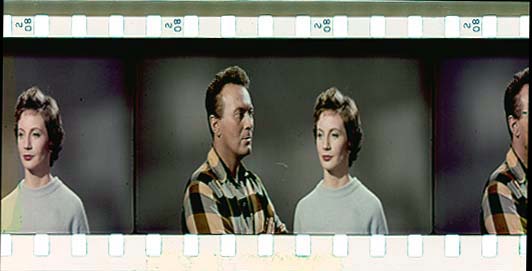 Technirama frame (8-perf horizontal) with 1.2x anamorphic squeeze, courtesy of Brian Pritchard
Technirama frame (8-perf horizontal) with 1.2x anamorphic squeeze, courtesy of Brian Pritchard
Technirama and Super Technirama
Aspect ratio: 2.35:1
Technirama and Super Technirama were competitors to CinemaScope. Developed by Technicolor in the early 1950s, the main difference between the two was the choice between 35mm or 70mm film. Technirama films were shot with the camera on its side and used 8 perfs per frame, effectively doubling the resolution over standard anamorphic 35mm film, for an aspect ratio on the negative of 2.2:1. The image would then be optically squeezed during processing to achieve an anamorphic 35mm print.
Some movies were presented in 70mm but were actually derived from the original 35mm, 8-perf anamorphic prints. Movies presented this way were marketed under the name "Super Technirama 70".
First used with The Monte Carlo Story (1956), Technirama died in the late 1960s with the exception of Disney's The Black Cauldron (1985), which was in Super Technirama 70.
Notable titles: Sleeping Beauty (1959), Spartacus (1960), El Cid (1961), The Pink Panther (1963)
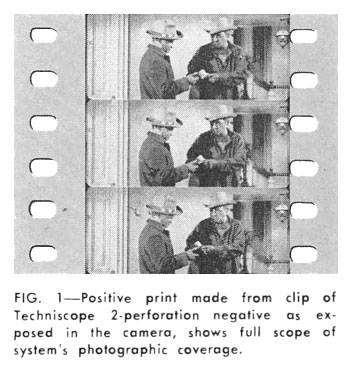 Techniscope example of a positive print, showing two perfs per frame. Courtesy of The American Widescreen Museum.
Techniscope example of a positive print, showing two perfs per frame. Courtesy of The American Widescreen Museum.
Techniscope
Techniscope was created by Technicolor Italia in the early 1960s. It created a widescreen negative (potentially 2.66:1, but usually 2.39:1) by utilizing only two perforations per frame with flat/spherical lenses. The advantages to this format include making the film stock last twice as long as 4-perf filming, cost savings by using spherical lenses instead of anamorphic, plus avoiding royalty payments for using patented technology. Because it also needs to be expanded for distribution onto a 4-perf frame, it results in the same kind of "gritty" look that occurs with Super 35.
However, as per late film critic Roger Ebert: "The movie is shot in Techniscope, a process designed to give a wide-screen picture while saving film and avoiding payment of royalties to the patented processes like Panavision. In this film, as in Harry Frigg, Techniscope causes washed-out color and a loss of detail. Universal shouldn't be so cheap."
Notable titles: A Fistfull of Dollars (1964), The Good, The Bad, and the Ugly (1966), THX 1138 (1971), American Hustle (2013)
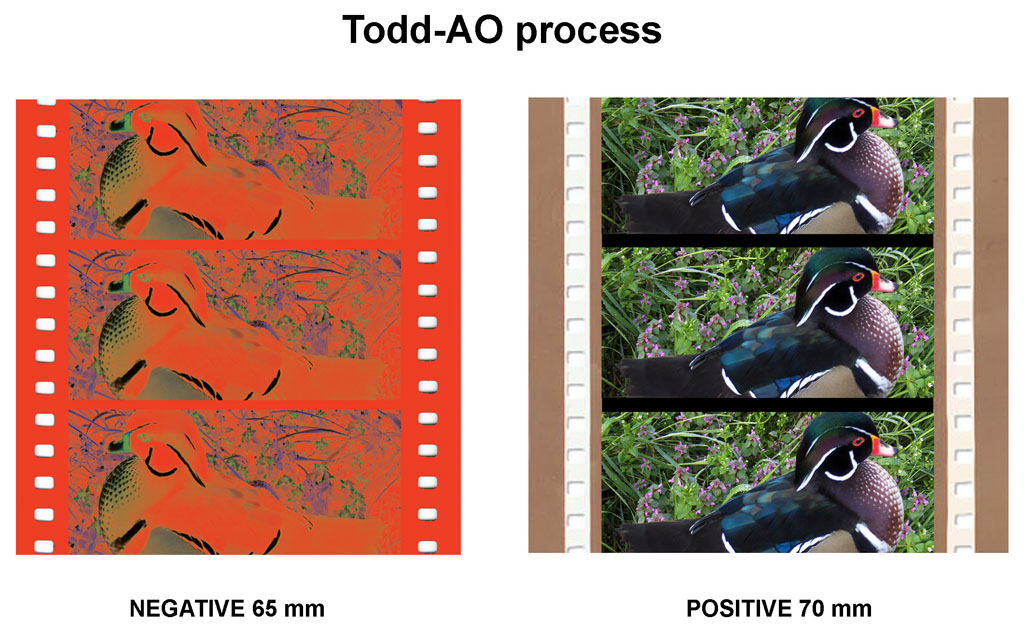 Negative and positive examples of a Todd-AO frame. Courtesy of Wikimedia
Negative and positive examples of a Todd-AO frame. Courtesy of Wikimedia
Todd-AO
Aspect ratio: 2.2:1
Todd-AO was developed in the early 1950s to be a single-camera alternative to Cinerama. The process involved filming on 65mm negatives which would then be contact printed onto 70mm positives, a process known as 65/70. The extra space was used to support the soundtrack, which allowed for six-channel sound. Oklahoma! and Around the World in 80 Days were filmed in Todd-AO using 30 frames per second as opposed to the industry standard 24.
The 65/70 process was later used in Super Panavision 70, Ultra Panavision 70, and IMAX.
Notable titles: Oklahoma! (1955), Around the World in 80 Days (1956), The Sound of Music (1965), Patton (1970)
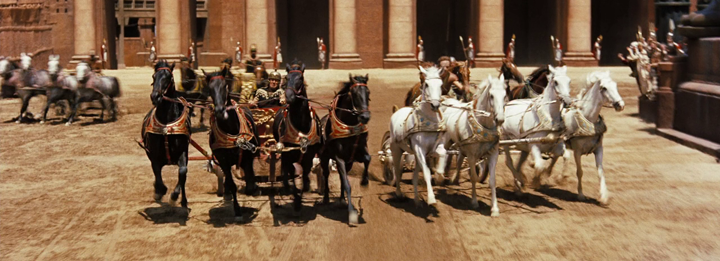 The chariot race from Ben-Hur showing the extreme 2.76:1 aspect ratio.
The chariot race from Ben-Hur showing the extreme 2.76:1 aspect ratio.
© 1959 MGM Productions
Ultra Panavision 70 / MGM Camera 65
Aspect ratio: 2.76:1 (when using 70mm film)
Ultra Panavision 70 was created through a joint production between MGM and Panavision to compete with Fox's highly successful CinemaScope. Similar to Todd-AO, Ultra Panavision 70 used the 65/70 method of processing the negative; however, it utilized a new type of lens that used two prisms in addition to the anamorphic lens. This minimized problems of actor close-ups that were encountered by using regular anamorphic lenses. The result was an extremely wide frame at 2.76:1 using a camera that was more easily focused and required less light. Like Todd-AO, Ultra Panavision 70 utilized a six-track audio system.
Notable titles: Ben-Hur (1959), Mutiny on the Bounty (1962), The Hateful Eight (2015), Rogue One (2016 using Ultra Panavision 70 lenses)
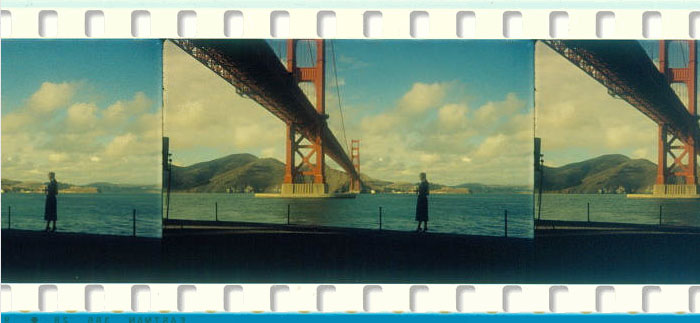 An example of a VistaVision frame from Alfred Hitchcock's Vertigo. Courtesy of The American Widescreen Museum
An example of a VistaVision frame from Alfred Hitchcock's Vertigo. Courtesy of The American Widescreen Museum
VistaVision
Aspect ratio: 1.66:1 to 2:1
Created by Paramount in 1954, VistaVision utilized standard 35mm film but the camera was mounted horizontally like Technirama and IMAX later on. This allowed each frame to be captured with 8 perfs per frame resulting in a very high quality print. It also allowed the film to be easily converted to standard 35mm formats. Projection in the horizontal 8-perf format was restricted to special premieres because of the need for special projectors. Traditional showings were done in standard 35mm. The format was rendered obsolete in 1961 as higher quality film stock was developed.
VistaVision cameras were later used for special effects, starting with the original Star Wars, because of the high quality of the resulting shots. The higher grain count of the 8-perf frames compensated for optical composition when the various elements were brought together. Several movies from 1980 to 2012 used VistaVision for special effects work, especially by Industrial Light & Magic. Although CGI rendered VistaVision obsolete (again) by the start of the 21st century, VistaVision cameras are still used on occasion when certain high-quality film shots are needed.
Notable titles: White Christmas (1954), The Ten Commandments (1956), Vertigo (1958)
 Example of a 1.33:1 silent film frame. This composite is from my own film scans and a screen shot from The Gold Rush, which is in the public domain.
Example of a 1.33:1 silent film frame. This composite is from my own film scans and a screen shot from The Gold Rush, which is in the public domain.
 The Phantom Menace ©1999 Lucasfilm, Ltd.
The Phantom Menace ©1999 Lucasfilm, Ltd. Standard 4-perf 35mm frame from Robocop 2 matted to apprx. 1.7:1. © 1990 Orion Pictures
Standard 4-perf 35mm frame from Robocop 2 matted to apprx. 1.7:1. © 1990 Orion Pictures

 Composite example was made by yours truly from multiple 35mm film sources.
Composite example was made by yours truly from multiple 35mm film sources.
 Marey Chronophotography gun
Marey Chronophotography gun Frame from the trailer for The Robe (1953) with an aspect ratio of 2.35:1
Frame from the trailer for The Robe (1953) with an aspect ratio of 2.35:1
 Woodcut of Cinéorama at 1900 Paris Exposition.Courtesy of Wikimedia.
Woodcut of Cinéorama at 1900 Paris Exposition.Courtesy of Wikimedia.
 Cinerama example of How The West Was Won
Cinerama example of How The West Was Won IMAX 70m frame from The Dark Knight Rises. Courtesy of The New York Times
IMAX 70m frame from The Dark Knight Rises. Courtesy of The New York Times
 Exmaple of a Super 35 frame.
Exmaple of a Super 35 frame. Example of Super35 back in the "pan-and-scan" days. Image is a relic from previous iterations of widescreen.org.
Example of Super35 back in the "pan-and-scan" days. Image is a relic from previous iterations of widescreen.org.
 Technirama frame (8-perf horizontal) with 1.2x anamorphic squeeze, courtesy of Brian Pritchard
Technirama frame (8-perf horizontal) with 1.2x anamorphic squeeze, courtesy of Brian Pritchard
 Techniscope example of a positive print, showing two perfs per frame. Courtesy of The American Widescreen Museum.
Techniscope example of a positive print, showing two perfs per frame. Courtesy of The American Widescreen Museum.
 Negative and positive examples of a Todd-AO frame. Courtesy of Wikimedia
Negative and positive examples of a Todd-AO frame. Courtesy of Wikimedia
 The chariot race from Ben-Hur showing the extreme 2.76:1 aspect ratio.
The chariot race from Ben-Hur showing the extreme 2.76:1 aspect ratio. An example of a VistaVision frame from Alfred Hitchcock's Vertigo. Courtesy of The American Widescreen Museum
An example of a VistaVision frame from Alfred Hitchcock's Vertigo. Courtesy of The American Widescreen Museum
